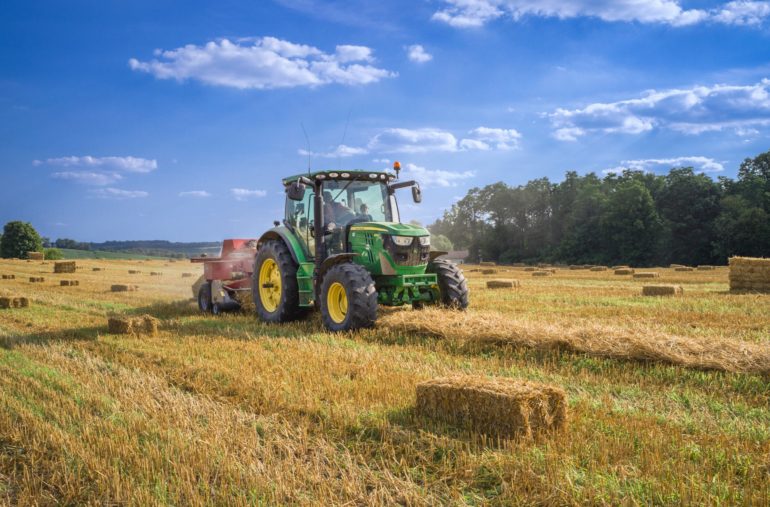Most scientists agree climate change has a profound impact on U.S. agricultural production. But estimates vary widely, making it hard to develop mitigation strategies. Two agricultural economists at the University of Illinois take a closer look at how choice of statistical methodology influences climate study results. They also propose a more accurate and place-specific approach to data analysis.
“If you pay attention to forecasts of how the climate will affect U.S. agriculture, the results are completely different. Some scientists predict it’s going to have a positive impact for the nation in the long run, some report it’s going to have a negative impact,” says study co-author Sandy Dall’Erba, professor in the Department of Agricultural and Consumer Economics (ACE) and director of the Center for Climate, Regional, Environmental and Trade Economics (CREATE) at U of I.
Dall’Erba and Chang Cai, doctoral student in ACE and the paper’s lead author, take stock of all the academic literature that estimates the impact of climate change on U.S. farmland values and revenues, focusing on every U.S. county. The county-level scale is not only more accurate, the researchers say, but also important for regional policy makers, because they can make county-specific decisions in areas where climate change is anticipated to pose a serious challenge.
“There is not a single commodity that is produced all over the U.S. The only way we can really understand the relationship between climate and agriculture is that rather than focusing on a particular crop or livestock, we look at economic impacts,” Dall’Erba notes. “Looking at aggregated agricultural outcomes allows us to compare the situation across every county in the U.S.”
The researchers look at how studies group locations for analysis, and how such groupings affect the results.
“Early studies would assume one additional degree of Celsius or Fahrenheit in Arizona will have the exact same marginal effect on agriculture as one additional degree in Illinois, which makes very little sense because you’re looking on the one hand at a place that is quite used to high temperature and low precipitation, versus a place which is used to moderate temperature and much more precipitation,” Dall’Erba says.
Recently, studies have tried to differentiate results and estimate effects based on local conditions. A popular approach is to divide the U.S. into irrigated versus rainfed areas, roughly across a west/east partition along the 100th meridian. While Illinois and Arizona would thus belong to different groups, Arizona and Montana would still be expected to experience similar marginal effects of weather.
Another method, which Dall’Erba has used in his own research, compares low- versus high-elevation areas, while a third approach is to group locations along state lines. Dall’Erba says researchers use the latter approach because it is straightforward to estimate and relevant for policy measures, but it does not produce very accurate results, since state lines rarely conform to atmospheric characteristics.
While all these approaches have some merit, they also have shortcomings.
“We discovered that results really do differ in terms of what the future impact of climate change will be if you choose one grouping versus another, especially in primary agricultural areas,” Cai explains. “We also found out that none of those groupings is better than any other in predicting what the future outcome will be.”
Cai and Dall’Erba recommend using one of three new statistical approaches that offer county-specific climate-impact estimates. All of these methods are driven by data and start without any assumptions on what the groups will look like. Instead, these methods analyze data to determine both the number of groups and who belongs to what group. These scientific techniques, called C-Lasso, causal forest algorithm, and geographically weighted regressions, have been used for analysis in other fields, such as the labor market and energy conservation, but they have not been used in climate change research before.
“You really let the data speak for themselves; you do not impose anything on your model. As soon as you start making choices on how one should group the observations, you’ve already guided your results in one direction. And then you’ll want to defend your choice. We’re hoping future researchers will be more cautious about a priori choices,” Dall’Erba explains.
Dall’Erba and Cai are already working on applying these new approaches to a comprehensive analysis of climate change and U.S. agricultural production. They expect to present their results in a forthcoming paper, and to guide the implementation of place-tailored climate change adaptation strategies.
The paper, “On the Evaluation of Heterogenous Climate Change Impacts on U.S. Agriculture: Does Group Membership Matter?” is published in Climatic Change.
Agricultural trade across US states can mitigate economic impacts of climate change
More information:
Chang Cai et al, On the evaluation of heterogeneous climate change impacts on US agriculture: does group membership matter?, Climatic Change (2021). DOI: 10.1007/s10584-021-03154-5
Provided by
University of Illinois at Urbana-Champaign
Citation:
Study proposes new ways to estimate climate change impacts on agriculture (2021, August 20)
retrieved 21 August 2021
from https://phys.org/news/2021-08-ways-climate-impacts-agriculture.html
This document is subject to copyright. Apart from any fair dealing for the purpose of private study or research, no
part may be reproduced without the written permission. The content is provided for information purposes only.



